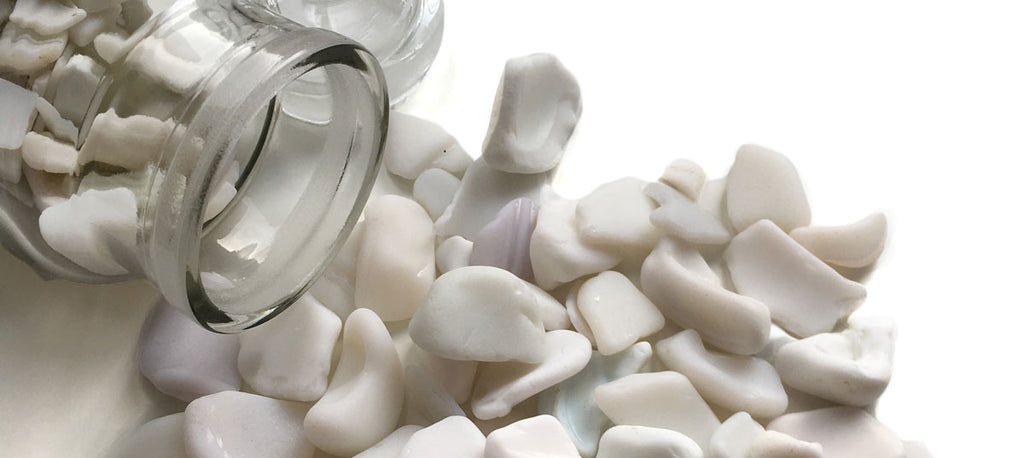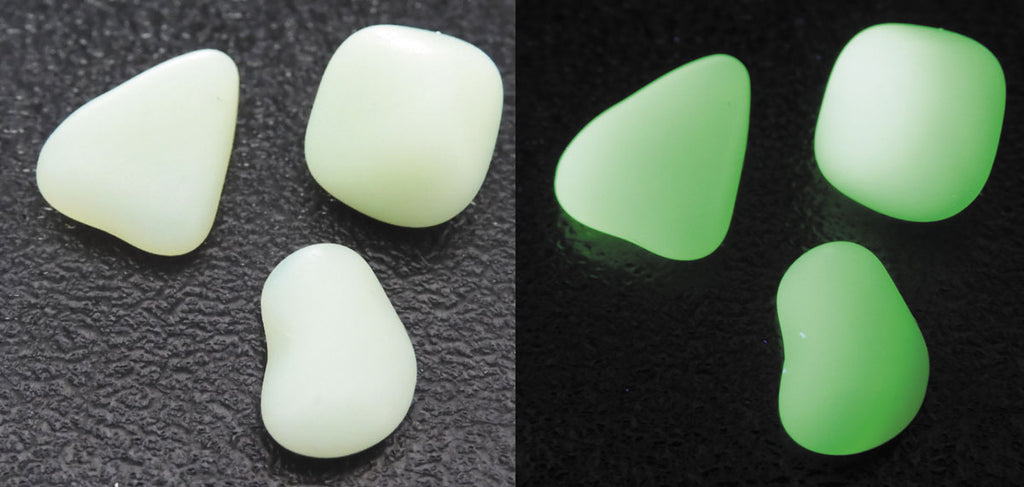No use crying over spilled milk

Sea-worn milk glass (Nicole Lind).
We know that most beachcombers don’t do a happy dance when they find a piece of opaque glass. These smooth white and pastel pieces are pretty, but they don’t give us the same thrill as finding a brightly colored piece of glass.

And though many of these little nuggets came from a commonplace cold cream jar or glassware that came free with someone’s purchase of oatmeal during the Depression, some of these milky pieces may have come from something a little more special.
There are several types of opaque and translucent glass that are typically grouped into the general term “milk glass.” Milk glass, also known as opal glass, is made by adding tin, zinc oxide, fluorides, phosphates, arsenic, antimony, or calcium in the form of bone ash (which creates a translucent opaline glass). Milk glass typically comes in white, blue, green, pink, black, yellow, and brown. Some milk glass was made with manganese dioxide to keep it bright white, and this compound reacts to sunlight over time turning the milk glass a light lavender.

Custard glass is a variant of milk glass with a subtle yellow shade reminiscent of pudding or custard. Custard glass was made by adding uranium oxide during manufacture, and the resulting glass fluoresces under long-wave black light.

Where did they come from? It’s impossible to determine where many pieces of opaque beach and sea glass originate, but it’s fun to imagine they came from something special. Clockwise from top left: pedestal milk glass bowl (Manfred Heyde), vintage ceiling lamps (Supermop/Shutterstock.com), blue mold-blown vase ca. 1840 (Manfred Heyde), opaque blue cabbage covered candy dish ca. 1900 (TheOrangeOne/Flickr), Heisey custard glass souvenir cup (Limulus), Federal Glass Golden Glory cup and saucer ca. 1950 (Misty Kelley), Consolidated Glass Co. pine cone salt/pepper shaker ca. 1900 (TheOrangeOne/Flickr), vintage bowl and cup (EvergreenPlanet/Shutterstocke.com), antique glass lampshade (slavapolo/Shutterstock.com). Heart of milk glass (Kirsti Scott).

Give it the “fire” test: Real opal glass casts an orange shadow or appears orange along thin edges, due to fine particles suspended in the glass and scattered by the light. This is called the Tyndall effect and is a great way to determine if your glass is genuine opal glass.
Milk glass was first made in Venice in the 15th or 16th century and became very popular beginning in the 1880s as a less-expensive substitute for porcelain. By the early 20th century, it was a status symbol, and early pieces of opal glass are highly collectible today.

Valued between $10 and $20 million, the four 24-inch wide faces of Grand Central Station are made of opal glass. (Jarrod Ligrani/Shutterstock.com).
Costume jewelry, lampshades, and decorative glassware were popular in this “Gilded Age” of the late 19th century. Milk glass was used on the face of the iconic clock in Grand Central Station in New York City when it was installed in 1913.

Susan H. Douglas Political Americana Collection, #2214. Division of Rare and Manuscript Collections, Cornell University Library.
Milk glass pieces were made for household use, but also in every shape and size, from commemorative plates to vases to figurative pieces. Pieces represented animals, political figures, characters from folk tales, and more. It was commonly used in cosmetic and toiletry bottles and jars, cream jars, and other lotions and perfumes. You can also find milk glass pitchers, syrup jars, match holders, salt and pepper shakers, candlesticks, and mustard jars.

There’s no shortage of milk glass, as illustrated by these shelves of vintage milk glass for sale in a thrift shop. (Edgar Lee Espe/Shutterstock.com).
During the Great Depression, companies who manufactured household goods, such as flour and tea, included milk glass teacups, saucers, and bowls in their bags, boxes, and canisters as a free gift. Gas stations and movie theaters also offered free glassware with a purchase. After the Depression, milk glass began to lose its status, and this beautiful glass was eventually replaced by heat-resistant Fire-King Jade-Ite from Anchor Hocking and Corning’s Pyrex glass. Milk glass is still used today in new and reproduction glass pieces, though it has never regained the popularity it enjoyed in the early 20th century. But remains of these pieces can still be found on beaches around the world, and each is a little bit of history. Next time you find a wave-tumbled piece of milk glass on the beach, just imagine where it may have come from, and maybe you actually will do a happy dance!
If you find a piece of opaque sea glass with ridges on one side, you may have found a piece of vitrolite beach glass.
Watch videos about all the colors of sea and beach glass
Learn more about sea and beach glass colors:
This article appeared in the Beachcombing Magazine March/April 2020 issue.








